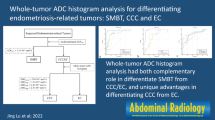Abstract
Purpose
This study aimed to evaluate whether histogram analysis of the apparent diffusion coefficient (ADC) of a solid tumor component could distinguish borderline ovarian tumors from ovarian carcinoma.
Materials and methods
Sixteen pathologically proven borderline tumors and 21 carcinomas were retrospectively examined. Magnetic resonance (1.5-T) image data sets were coregistered, and the solid components of each tumor were semiautomatically segmented. ADC histograms of the solid components were extracted; modes, minimums, means, and 10th, 25th, 50th, 75th, and 90th percentiles of the histograms were compared between the two tumor types, and receiver-operating characteristic (ROC) analysis was performed.
Results
The mode, minimum, mean, 10th, 25th, 50th, and 75th percentile ADC values of solid components of borderline tumors were significantly larger than those of carcinomas. Among these, the 10th percentile values had the lowest p value (p = 0.0003). At ROC analysis, the area under the curve (AUC) in the 10th percentile was the greatest (0.854), and the best cutoff value in the 10th percentile provided the highest specificity (93.8 %).
Conclusions
ADC histograms of solid tumor components facilitated the distinction between borderline ovarian tumors and carcinoma. The 10th percentile ADC values had the best diagnostic performance.





Similar content being viewed by others
Abbreviations
- ADC:
-
Apparent diffusion coefficient
- DWI:
-
Diffusion-weighted imaging
References
Skirnisdottir I, Garmo H, Wilander E, Holmberg L. Borderline ovarian tumors in Sweden 1960–2005: trends in incidence and age at diagnosis compared to ovarian cancer. Int J Cancer. 2008;123(8):1897–901.
Canfarotta M, Gillan E, Balarezo F, Campbell B, Tsai A, Finck C. Diagnosis, surgical treatment, and management of borderline ovarian surface epithelial neoplasms: report of 2 cases and review of literature. J Pediatr Surg Case Rep. 2014;2(10):468–72.
Fauvet R, Boccara J, Dufournet C, David-Montefiore E, Poncelet C, Darai E. Restaging surgery for women with borderline ovarian tumors: results of a French multicenter study. Cancer. 2004;100(6):1145–51.
Koutlaki N, Dimitraki M, Zervoudis S, Sofiadou V, Grapsas X, Psillaki A, et al. Conservative surgery for borderline ovarian tumors–emphasis on fertility preservation. A review. Chirurgia (Bucur). 2011;106(6):715–22.
de Souza NM, O’Neill R, McIndoe GA, Dina R, Soutter WP. Borderline tumors of the ovary: CT and MRI features and tumor markers in differentiation from stage I disease. Am J Roentgenol. 2005;184(3):999–1003.
Takeuchi M, Matsuzaki K, Nishitani H. Diffusion-weighted magnetic resonance imaging of ovarian tumors: differentiation of benign and malignant solid components of ovarian masses. J Comput Assist Tomo. 2010;34(2):173–6.
Li WH, Chu CT, Cui YF, Zhang P, Zhu MJ. Diffusion-weighted MRI: a useful technique to discriminate benign versus malignant ovarian surface epithelial tumors with solid and cystic components. Abdom Imaging. 2012;37(5):897–903.
Lambregts DM, Beets GL, Maas M, Curvo-Semedo L, Kessels AG, Thywissen T, et al. Tumor ADC measurements in rectal cancer: effect of ROI methods on ADC values and interobserver variability. Eur Radiol. 2011;21(12):2567–74.
Bonekamp D, Bonekamp S, Halappa VG, Geschwind JF, Eng J, Corona-Villalobos CP, et al. Interobserver agreement of semi-automated and manual measurements of functional MRI metrics of treatment response in hepatocellular carcinoma. Eur J Radiol. 2014;83(3):487–96.
Kwee RM, Dik AK, Sosef MN, Berendsen RC, Sassen S, Lammering G, et al. Interobserver reproducibility of diffusion-weighted MRI in monitoring tumor response to neoadjuvant therapy in esophageal cancer. PLoS One. 2014;9(4):e92211.
Downey K, Riches SF, Morgan VA, Giles SL, Attygalle AD, Ind TE, et al. Relationship between imaging biomarkers of stage I cervical cancer and poor-prognosis histologic features: quantitative histogram analysis of diffusion-weighted MR images. Am J Roentgenol. 2013;200(2):314–20.
Donati OF, Mazaheri Y, Afaq A, Vargas HA, Zheng J, Moskowitz CS, et al. Prostate cancer aggressiveness: assessment with whole-lesion histogram analysis of the apparent diffusion coefficient. Radiology. 2014;271(1):143–52.
Kim EJ, Kim SH, Park GE, Kang BJ, Song BJ, Kim YJ, et al. Histogram analysis of apparent diffusion coefficient at 3.0t: Correlation with prognostic factors and subtypes of invasive ductal carcinoma. J Magn Reson Imaging. 2015.
Tha KK, Terae S, Nakagawa S, Inoue T, Kitagawa N, Kako Y, et al. Impaired integrity of the brain parenchyma in non-geriatric patients with major depressive disorder revealed by diffusion tensor imaging. Psychiat Res-Neuroim. 2013;212(3):208–15.
Otsu N. A threshold selection method from gray-level histograms. IEEE Transactions on Systems, Man and Cybernetics In N/A. 1979;9:1.
Hart WR. Borderline epithelial tumors of the ovary. Mod Pathol. 2005;18:S33–50.
Guo Y, Cai YQ, Cai ZL, Gao YG, An NY, Ma L, et al. Differentiation of clinically benign and malignant breast lesions using diffusion-weighted imaging. J Magn Reson Imaging. 2002;16(2):172–8.
Gibbs P, Liney GP, Pickles MD, Zelhof B, Rodrigues G, Turnbull LW. Correlation of ADC and T2 measurements with cell density in prostate cancer at 3.0 Tesla. Invest Radiol. 2009;44(9):572–6.
Manenti G, Di Roma M, Mancino S, Bartolucci DA, Palmieri G, Mastrangeli R, et al. Malignant renal neoplasms: correlation between ADC values and cellularity in diffusion weighted magnetic resonance imaging at 3 T. Radiol Med. 2008;113(2):199–213.
Fujii S, Kakite S, Nishihara K, Kanasaki Y, Harada T, Kigawa J, et al. Diagnostic Accuracy of Diffusion-Weighted Imaging in Differentiating Benign From Malignant Ovarian Lesions. J Magn Reson Imaging. 2008;28(5):1149–56.
Thomassin-Naggara I, Darai E, Cuenod CA, Fournier L, Toussaint I, Marsault C, et al. Contribution of diffusion-weighted MR imaging for predicting benignity of complex adnexal masses. Eur Radiol. 2009;19(6):1544–52.
Zhang P, Cui YF, Li WH, Ren G, Chu CT, Wu XR. Diagnostic accuracy of diffusion-weighted imaging with conventional MR imaging for differentiating complex solid and cystic ovarian tumors at 1.5T. World J Surg Oncol. 2012;10.
Author information
Authors and Affiliations
Corresponding author
Ethics declarations
Conflict of interest
None.
About this article
Cite this article
Mimura, R., Kato, F., Tha, K.K. et al. Comparison between borderline ovarian tumors and carcinomas using semi-automated histogram analysis of diffusion-weighted imaging: focusing on solid components. Jpn J Radiol 34, 229–237 (2016). https://doi.org/10.1007/s11604-016-0518-6
Received:
Accepted:
Published:
Issue Date:
DOI: https://doi.org/10.1007/s11604-016-0518-6




